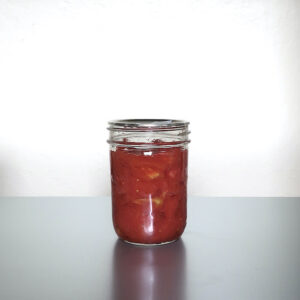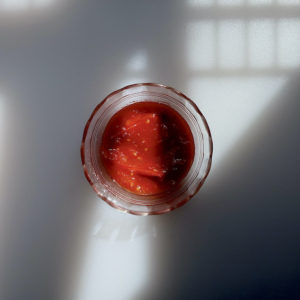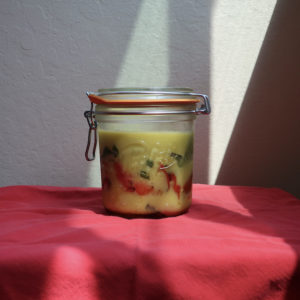Notes on Canning Tomatoes

The literature of canning abounds in talk of capturing time. Terms like “peak freshness”, “seasonality”, and “ripeness” are certain to appear whenever people begin musing over the meaning of canning.
It’s all true. To can tomatoes in August is to hope you’ll be opening the jars in February. To gaze upon last year’s jars–only five left now–is to recall exactly what you were doing in August 2014, when you pushed aside whatever else was happening because the tomatoes were in. Time to fire up the canner, lay in jars and lids and bands. Replenish supplies of canning salt and citric acid. Stand in the hot kitchen. Time to can tomatoes.
Canning had its beginnings in brute necessity. Only by preserving the harvest did American farmers stand a chance of surviving the winter. The contents of jars and the root cellar were all that stood between families and starvation. The Little House books offer compelling narratives about whether or not there will be food enough to last the winter; Little House In The Big Woods begins with Pa killing a deer. He proceeds to build a smokehouse in the yard, preserving the venison with hickory smoke. There’s plenty to eat in Little House. In The Long Winter, a book devoting a lot of thought to food, there isn’t. The Ingalls family subsists on coarse brown bread until spring. When the trains are finally able to make it into town, the famished family celebrates by roasting an enormous turkey. In Little Town On The Prairie, Ma makes preserves while Laura and Carrie attend school: “The house was full of the sirupy scent of preserves and the spicy odor of pickles.”
We no longer can to survive a nonexistent winter. Canning isn’t a dying art, but it is a marginal one. Practice pressure canning and you’re even closer to the edge. Still, we canners are out there. Barbara Kingsolver, writing in Animal, Vegetable, Miracle, calls canning “fast food, paid for in time up front.” Maxine Kumin, whose 2014 death was not lamented loudly enough, maintained an enormous garden whose contents she canned , jammed, and wrote beautifully of in “Enough Jam For A Lifetime” and “The Country Kitchen.” Novella Carpenter, she of the urban farm, knows her way around a canner, and even Alice Waters, queen of fresh produce, offers canning recipes in her cookbooks. And no piece about canning can overlook the wonderful Eugenia Bone, whose modern writing on canning provides a touchstone for all of us.
—
When the first 20 pound box of Roma tomatoes arrived in The Insufficient Kitchen last Friday, circumstances conspired against me. I did not get to work until mid-afternoon Saturday. Canning is not a process to be undertaken lightly: Botulism is a potent neurotoxin. You don’t want to court it.
—
For every fond remembrance of canning seasons past there are moments of current anxiety. Canning is physically taxing work. Standing in a hot kitchen, you perform repetitive tasks: cutting, peeling, seeding, squeezing. Jars must be washed in hot soapy water. Acids from the tomatoes burn your hands. Should you suffer from Carpal Tunnel, Repetitive Stress Injury, and Tendonitis, well, prepare for intense pain. Wonder how long you can keep this up.
Why bother? Because capitulation is unbearable. Because home-canned tomatoes are better than even the finest imported Italian tomatoes. Because to can tomatoes is to always have the perfect gift.
This last is important. Food gifts run the gamut from the abominable (pecan-studded fruitcakes) to the coveted (Beluga caviar). Canned tomatoes rise to every occasion. They can be offered to nearly everyone: the gluten-sensitive, the religiously observant, the vegetarian. They can be offered in happiness, in thanks, in sorrow. Canned tomatoes say everything you cannot: I am beyond words at your cancer diagnosis. At your child’s mortal illness. Thank you for fixing my husband’s wheelchair. Canned tomatoes gracefully convey these sentiments without embarrassment or emotional excess for giver or receiver.
Which is why canning 100 pounds isn’t enough. I need to order more.

Instructions on tomato canning to come shortly.
Laura Ingalls Wilder: The Little House Books. Harper And Row, New York
Barbara Kingsolver: Animal, Vegetable, Miracle. Harper Collins, New York
Maxine Kumin’s “Enough Jam For A Lifetime” appears in Women, Animals, And Vegetables, Norton Books, New York. “The Country Kitchen” appears in In Deep: Country Essays, Beacon Press, Boston.




